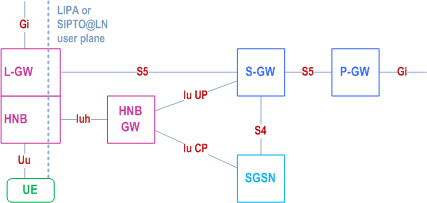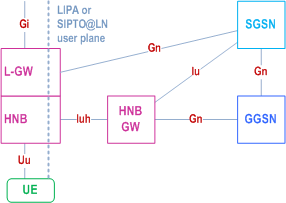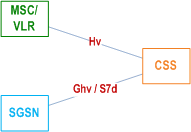Content for TS 23.060 Word version: 18.0.0
1…
5…
5.3.8…
5.4…
5.4.2…
5.4.9…
5.6…
5.6.2
5.6.3…
5.6.3.7…
5.7…
6…
6.3…
6.5…
6.6…
6.8…
6.9…
6.9.1.3
6.9.2…
6.9.2.2…
6.9.2.2.2
6.9.2.2.3…
6.9.2.2.5…
6.9.3…
6.10…
6.12…
6.13…
6.13.1.2…
6.13.2…
6.13.2.2
6.14…
8…
8.2
9…
9.2.2…
9.2.2.2
9.2.2.3…
9.2.3…
9.2.3.2…
9.2.3.3…
9.2.4…
9.2.4.2…
9.2.5…
12…
12.5…
12.6…
12.7…
12.8…
13…
14…
15…
15.3…
16…
16.2…
A…
B…
5.4.9 HNB subsystem
5.4.10 CSG Subscriber Server
5.4.11 RAN Congestion Awareness Function (Iu mode)
5.5 Assignment of Functions to General Logical Architecture
...
...
5.4.9 HNB subsystem |R9| p. 57
A HNB subsystem consists of a HNB, a HNB GW and optionally a Local GW.
The Local IP Access function and SIPTO at the Local Network with L-GW function collocated with HNB is achieved using a Local GW (L-GW) co-located with the HNB.
Figure 5.4.9-1 and Figure 5.4.9-2 illustrate LIPA and SIPTO at the Local Network with L-GW function collocated with HNB for HNB connected to respectively EPC and Gn-based SGSN.


The HNB Subsystem appears as an RNS to the core network and is connected by means of the Iu-CS interface to the MSC and by means of the Iu-PS interface to the SGSN. When LIPA or SIPTO at the Local Network L-GW function collocated with HNB is activated, the HNB subsystem also has following interface to the core network i.e.:
- For S4-SGSN, an S5 interface between the S-GW and the Local GW;
- For Gn-based SGSN, a Gn interface between the SGSN and the Local GW.
5.4.10 CSG Subscriber Server |R11| p. 58
CSG Subscriber Server (CSS) is an optional element that stores CSG subscription data for roaming subscribers. The CSS stores and provides VPLMN specific CSG subscription information to the SGSN. The CSS is accessible from the Gn/Gp SGSN via the Ghv interface and from the S4-SGSN via the S7d interface. The CSS is always in the same PLMN as the current SGSN.
If the same CSG ID exists in both CSS subscription data and HLR/HSS subscription data, the CSG subscription data from HLR/HSS shall take precedence over the data from CSS.
Figure 5.4.10-1 illustrates CSS connected to SGSN and MSC/VLR.

5.4.11 RAN Congestion Awareness Function (Iu mode) |R13| p. 59
The RAN Congestion Awareness Function (RCAF) is an element that provides RAN User Plane Congestion Information (RUCI) to the PCRF to enable the PCRF to take the RAN user plane congestion status into account for policy decisions.
The RCAF collects information related to user plane congestion from the RAN's OAM system based on which the RCAF determines the congestion level, the identifier of the impacted UTRAN cell and the IMSIs served by the impacted cell.
Via the Nq' interface the RCAF retrieves the APNs of the active PDN connections of the UEs in the congested cell.
Via the Np reference point, the RCAF sends the RUCI to the PCRFs serving the UEs' PDN connections.
The RCAF is available for UTRAN access only.
Figure 5.4.11-1 illustrates the RCAF connected to the S4-SGSN or Gn/Gp-SGSN. The RCAF is located in the same PLMN as the serving SGSN except in network sharing scenarios where the RCAF belongs to the RAN operator.

5.5 Assignment of Functions to General Logical Architecture p. 60
The functions identified in the functional model are assigned to the logical architecture.
| Function | A/Gb mode MS | Iu mode MS | A/Gb mode RAN | Iu mode RAN | A/Gb mode SGSN | Iu mode SGSN | Serving GW | GGSN | P-GW | HLR |
|---|---|---|---|---|---|---|---|---|---|---|
| Network Access Control: | ||||||||||
| Registration | X | |||||||||
| Authentication and Authorisation | X | X | X | X | X | |||||
| Admission Control | X | X | X | X | X | X | X | X | X | |
| Message Screening | X | X | ||||||||
| Packet Terminal Adaptation | X | X | ||||||||
| Charging Data Collection | X | X | X | X | X | |||||
| Operator Determined Barring | X | X | X | |||||||
| Packet Routeing & Transfer: | ||||||||||
| Relay | X | X | X | X | X | X | X | X | X | |
| Routeing | X | X | X | X | X | X | X | X | X | |
| Address Translation and Mapping | X | X | X | X | X | X | X | X | ||
| Encapsulation | X | X | X | X | X | X | X | X | ||
| Tunnelling | X | X | X | X | X | X | ||||
| Compression | X | X | X | X | ||||||
| Ciphering | X | X | X | X | X | |||||
| Mobility Management: | X | X | X | X | X | X | X | X | ||
| Logical Link Management: | ||||||||||
| Logical Link Establishment | X | X | ||||||||
| Logical Link Maintenance | X | X | ||||||||
| Logical Link Release | X | X | ||||||||
| Radio Resource Management: | X | X | X | X | X | |||||